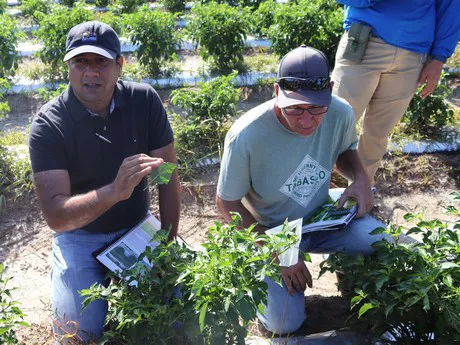On a warm June morning, a team of horticulture scientists from the LSU AgCenter and agricultural staff from McIlhenny Company walked fields of hot peppers looking for invaders — weeds, diseases and insects that could damage Tabasco’s main ingredient during a hands-on field training.
“This is an opportunity to show workers in the industry the damaging effects of pests and diseases and competition from weeds and their relation to food production,” said LSU AgCenter plant pathologist Raj Singh.
AgCenter “plant doctor” Singh and his team have been working with the McIlhenny Company to train their agricultural staff to recognize and treat for pest problems on their peppers.
The five-year project funded by McIlhenny Company is focused on developing and implementing integrated pest management strategies to mitigate the use of pesticides for Tabasco pepper seed production.

Raj Singh (left), LSU AgCenter “plant doctor,” is one of several LSU AgCenter specialists working with McIhenny Company employees to help them diagnose and treat pest problems in their pepper fields. Photo by Brianna Cobb/LSU AgCenter
“The key to finding an optimal solution to pest management and plant degradation is observing whether the vegetation is infected by a disease or a disorder. This distinction can be made by perceiving the difference between type and pattern of symptoms and signs present in the field,” Singh said.
The plant doctor also noted the differences between beneficial and harmful insects, sharing a publication he contributed to that provides pictures of all types of pests and natural enemies. Workers were eager to study the book as few could distinguish between the different types of insects that regularly infest their fields
Participants also were instructed on proper methods to calibrate sprayers by Kiki Fontenot, AgCenter vegetable specialist. She updated the Tabasco team on sustainable management practices.
“You can use specific nutrients and consistent irrigation practices to reduce stress on plants and manage drainage in order to lower vegetation stunting in saturated areas,” Fontenot said.
Fontenot stressed the importance of regularly calibrating both backpack sprayers and large tanks, tasks that often are forgotten during periods of heavy harvesting.
AgCenter weed specialist Ron Strahan also trained the Tabasco crew in identifying major weed species in the pepper fields. He showed the participants special plant characteristics that can be used differentiate similar weeds, such as purple nutsedge and yellow nutsedge.
“Purple nutsedge is the No. 1 weed in the world and the No. 1 weed problem in the Avery Island Tabasco pepper fields,” Strahan said
Strahan shared the results of his purple nutsedge control research trials conducted at Avery Island. He emphasized the importance of timing herbicide applications on annual grasses early in the growth stage for more effective control and higher pepper yields
Since inviting the AgCenter specialists, the McIlhenny Company has seen an increase in employee moral and field production because workers are able to gain a hands-on approach to common issues.
Singh encouraged them to provide soil samples and plant specimens to be diagnosed and evaluated at the AgCenter Plant Diagnostic Center.
“The most important aspect of this project is my accessibility,” Singh stated. “If I’m able to help local agriculturalist just by sharing what I’ve learned, the drive from LSU to Avery Island will always be worth it.”
Source: LSU AgCenter (Brianna Cobb)
